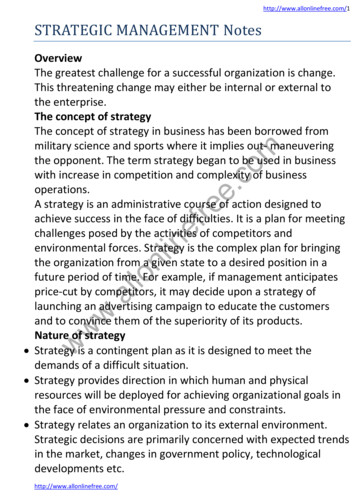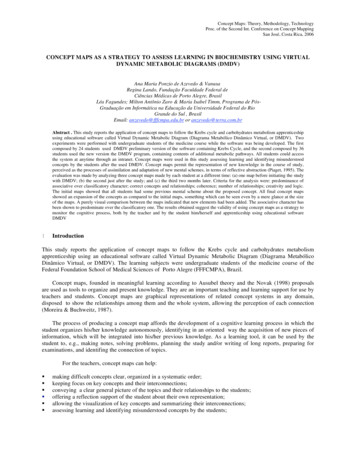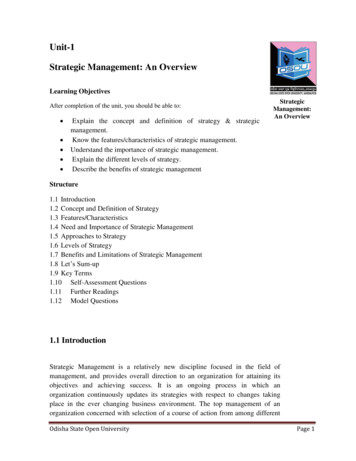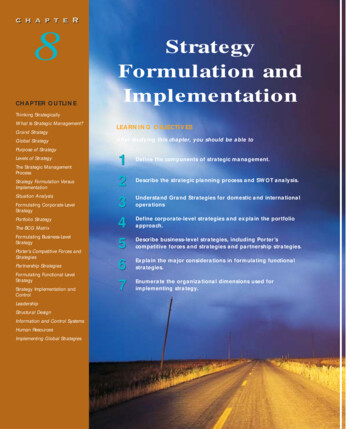
Transcription
http://www.allonlinefree.com/1STRATEGIC MANAGEMENT Noteswww.allonlinefree.comOverviewThe greatest challenge for a successful organization is change.This threatening change may either be internal or external tothe enterprise.The concept of strategyThe concept of strategy in business has been borrowed frommilitary science and sports where it implies out- maneuveringthe opponent. The term strategy began to be used in businesswith increase in competition and complexity of businessoperations.A strategy is an administrative course of action designed toachieve success in the face of difficulties. It is a plan for meetingchallenges posed by the activities of competitors andenvironmental forces. Strategy is the complex plan for bringingthe organization from a given state to a desired position in afuture period of time. For example, if management anticipatesprice-cut by competitors, it may decide upon a strategy oflaunching an advertising campaign to educate the customersand to convince them of the superiority of its products.Nature of strategy Strategy is a contingent plan as it is designed to meet thedemands of a difficult situation. Strategy provides direction in which human and physicalresources will be deployed for achieving organizational goals inthe face of environmental pressure and constraints. Strategy relates an organization to its external environment.Strategic decisions are primarily concerned with expected trendsin the market, changes in government policy, technologicaldevelopments etc.http://www.allonlinefree.com/
m Strategy is an interpretative plan formulated to give meaning toother plans in the light of specific situations. Strategy determines the direction in which the organization isgoing in relation to its environment. It is the process of definingintentions and allocating or matching resources to opportunitiesand needs, thus achieving a strategic fit between them. Businessstrategy is concerned with achieving competitive advantage. The effective development and implementation of strategydepends on the strategic capability of the organization, whichwill include the ability not only to formulate strategic goals butalso to develop and implement strategic plans through theprocess of strategic management. A strategy gives direction to diverse activities, even though theconditions under which the activities are carried out are rapidlychanging. The strategy describes the way that the organization will pursueits goals, given the changing environment and the resourcecapabilities of the organization. It provides an understanding of how the organization plans tocompete. It is the determination and evaluation of alternatives available toan organization in achieving its objectives and mission and theselection of appropriate alternatives to be pursued. It is the fundamental pattern of present and planned objectives,resource deployments, and interactions of a firm with markets,competitors and other environmental factors.A good strategy should specify; What is to be accomplished Where, i.e., which product/markets it will focus onhttp://www.allonlinefree.com/
m How i.e., which resources and activities will be allocated to eachproduct/market to meet environmental opportunities andthreats and to gain a competitive advantageComponents of strategy1. Scope; refers to the breadth of a firm’s strategic domain i.e., thenumber and types of industries, product lines, and markets itcompetes in competes in or plans to enter.2. Goals and objectives; these specify desires such as volumegrowth, profit contribution or return on investment over aspecified period.3. Resource deployment; strategy should specify how resourcesare to be obtained and allocated across businesses,product/markets, financial departments, and activities.4. Identification of a sustainable competitive advantage; it refers toexamining the market opportunities in each business andproduct-market and the firm’s distinctive competencies orstrengths relative to competitors.5. Synergy; this exists when the firm’s businesses, products,markets, resource deployments and competencies complementone another i.e., the whole becomes greater than the sum of itsparts( 2 2 5)Strategies can be classified into corporate, business-unit andfunctional strategies.Definition; Strategic management is the process by which topmanagement determines the long-term direction of theorganization by ensuring that careful formulation,implementation and continuous evaluation of strategy takeplace.The strategic management processThe process can be broken down into three phases; Strategy formulationhttp://www.allonlinefree.com/
m Strategy implementation Strategy controlStrategy formulation involves; Defining the organization’s guiding philosophy & purpose ormission. Establishing long-term objectives in order to achieve themission. Selecting the strategy to achieve the objectives.Strategy implementation involves; Establishing short-range objectives, budgets and functionalstrategies to achieve the strategy.Strategy control involves the following; Establishing standards of performance. Monitoring progress in executing the strategy. Initiating corrective actions to ensure commitment to theimplementation of the strategy.Defining an organization’s purpose/mission The mission defines the fundamental reason for theorganization’s existence. It provides a framework for decisionmaking that gives direction for the entire organization. It is an overall goal of the organization that provides a sense ofdirection and a guide to decision-making for all levels ofmanagement i.e. organizational objectives and strategies atlower levels are developed from the mission. The mission describes the organization’s line of business, itsproducts and specifies the markets it serves within a time frameof 3 to 5 years. The mission defines the boundaries or domain within which theorganization will operate. The boundaries may be defined asindustries or types of industries.http://www.allonlinefree.com/
m The mission should not prevent change but provides directionfor seeking new opportunities. It should be broad enough to allow exploitation of newopportunities but specific enough to provide direction. A mission should be achievable, in writing and should have atime frame for achievement.Mission statements should include the following components; Targets customers and markets Principal products Geographic domain Core technologies used Concern for survival, growth and profitability Organizational self concept Desired public image. The organization’s guiding philosophyThe organization’s philosophy establishes the values and beliefsof the organization about how the business should be done andthe organization’s role in the society.It establishes the relationship between the organization and itsstakeholders i.e. its responsibilities towards customers,employees, shareholders and general public.Establishing organizational objectivesAn objective is a statement of what is to be achievable,measurable and stated with specific time frames.They can be classified as either short-range, medium or longrange.They may also be corporate, business unit or functional/departmental objectives.Organizational objectives may be in the following areas;1. Profitability 2. Service to customers 3. Employee wellbeingand welfare 4. Social responsibility.http://www.allonlinefree.com/
http://www.allonlinefree.com/6come.allonlin re ef Strategic business units (SBUs)A large organization’s activities can be segmented as businessunits.A business unit is an operating unit in an organization that sells adistinct set of products to a distinct market in competition with awell defined set of competitors. It is normally referred to as anSBU.An organizational SBU often has the following characteristics;It has its own set of customers.It should have a clear set of competitors, which it is trying tosurpass.It should have its own strategic planning manager responsiblefor its success.Its performance must be measurable in terms of profit and loss,i.e. it must be a true profit centre.e.g. K.B.C.’s SBUs include; K.B.C Kiswahili, K.B.C. English, MetroFM, K.B.C. T.V, Metro TV etc.wwwBenefits of strategic management It provides the organization with consistency of action i.e. helpsensure that all organizational units are working toward the sameobjectives (direction). The process forces managers to be more proactive andconscious of their environments i.e. to be future oriented. It provides opportunity to involve different levels ofmanagement, encourage the commitment of participatingmanagers and reducing resistance to proposed change.http://www.allonlinefree.com/
7http://www.allonlinefree.com/
oANALYZING THE EXTERNAL ENVIRONMENTIn deciding an organization’s future direction, managers mustanswer three questions; What is the organization’s present position? Where does the management want the organization to be infuture? (objectives) How does the organization move from its present position to thefuture desired position?The first question is answered through the analysis of the firm’sexternal and internal environment.The environment is a major source of change. Some firmsbecome victims of this change while others use it to theiradvantage.http://www.allonlinefree.com/
mThe purpose of environmental analysis is to enable the firm toturn change to its advantage by being proactive.Characteristics of the environment are; It is unique to every organization. It is constantly changing. One level is controllable while the other (remote-PESTEL) isuncontrollable. It is a source of Opportunities, Threats, Strengths & Weaknesses.Environmental analysis can be divided into two major steps;a. Defining; determining the relevant environmental forces.b. Scanning & forecasting; collecting information concerning thedefined environment.Defining the external environmentExternal forces form the basis of the opportunities and threatsthat a firm faces. These are;1. Political /legal factors; They define the legal and regulatoryframework within which firms must operate. Constraints areplaced on firms through fair trade practices, minimum wagelegislation, pollution and pricing policies aimed at protecting theemployees, consumers, the general public and the environment.Such actions reduce the profit potential of the firms. However,others such as patent laws and government subsidies aredesigned for the benefit and protection of firms.2. Economic factors; They affect consumer spending power andconsumption patterns.Managers must consider the general availability of finance, thelevel of disposable income and people’s consumption patterns.Other factors are; the level of interest rates, inflation rates,trend of growth in GDP, the emergency of trading blocs(EAC,ECOWAS) and levels of employment.http://www.allonlinefree.com/
om3. Social factors; These include the values, beliefs, attitudes andlifestyles of people. As people’s attitudes change, so does thedemand for various types of products. Other examples of socialchange include; Entry of large numbers of women in the labour market Shifts in age distribution Geographic shifts in population Increased levels of education and sophistication4. Technological factors; Technology refers to the means used todo useful work. To avoid product obsolescence and promoteinnovation, a firm must be aware of technological changes thatinfluence its industry. Innovative technologies can lead topossibilities of a new product, product improvements orimprovement in production and marketing techniques.Environmental forecasting techniquesEnvironmental variables are dynamic and forecasting enables afirm to assess the future and make plans for it.Forecasting techniques can be classified as either qualitative orquantitative.Qualitative techniques are based primarily on opinions andjudgements, on data that cannot be statistically analyzed.Quantitative techniques are based on the analysis of data by useof statistical techniques.Qualitative forecasting techniques1. Delphi method; This is a method of developing a consensus ofexpert opinion. A panel of experts is chosen to study a particularproblem. Panel members do not meet as a group. They areasked to give an opinion about certain future events. After thefirst round of opinions has been collected, the co-coordinatorsummarizes the opinions and sends the information to panelmembers. Based on this information, the panel members rethinkhttp://www.allonlinefree.com/
omtheir earlier responses and make a second forecast. The sameprocedure continues until a consensus is reached.2. Executive judgment; This is a method of forecasting based onthe intuition of one or more executives. The approach may workwell where the forecaster has past market experience. A majordemerit is that the forecaster may be too pessimistic oroptimistic.3. Customer surveys; In this case customers are asked what typesand quantities of products they intend to buy during a specifiedperiod of time. But this may only be possible where the businesshas few customers who may be able to make accurate estimatesof future product requirements. The disadvantage is that acustomer survey may only reflect customers’ purchaseintentions and not actual purchases.4. Sales force forecasting survey; Sales people are asked toestimate the anticipated sales in their territories for a specifiedperiod.Merits; Sales people are closer to customers and are better placed toknow the customers’ future product needs.Demerits; The sales people can be too pessimistic or optimistic. They tend to underestimate the sales potential in theirterritories.Quantitative techniques1. Time series analysis; This technique forecasts future demandbased on what has happened in the past. The idea is to fit atrend line to historical data and then extrapolate this line intothe future. The method assumes that historical data will form asimilar pattern into the future.http://www.allonlinefree.com/
om2. Regression modelling; This is a forecasting technique in whichan equation with one or more variables is used to predictanother variable. The one being predicted is called thedependent variable and the other variables used to predict it arethe independent variables. The technique determines howchanges in the independent variables affect the dependentvariable. Once a relationship is established, future values for thedependent variable can be forecast based on predicted values ofthe independent variables.Industry and competitive analysisThis involves examining a firm’s industry and competitiveenvironment. Factors considered are; Industry structure Factors that determine competition The key factors for success in an industry.Competitive analysis helps to define the company’s distinctivecompetence and competitive advantage.A distinctive competence is an activity or resource where thefirm’s position is superior to its rivals.A competitive advantage refers to a firm’s superior competitiveposition that allows it to achieve higher profitability than theindustry’s average.Purpose of industry and competitive analysis Defining a firm’s industry and served market. An industry is agroup of companies that offer products that satisfy similarcustomer needs. A served market is the portion of the industrythat the company targets. Identifying business opportunities- i.e. new market trends andniches a firm can serve. Providing a benchmark for evaluating the company relative tocompetitors.http://www.allonlinefree.com/
om Shortening the company’s response time to competitors’ movesor pre-empting such moves. Helping a firm to gain a competitive advantage. Aiding in the development of strategy and its successfulimplementation.Understanding the industry’s life cycleIndustries come into existence and change over time due totechnological, social and economic changes and managers needto understand these changes because they affect the intensityand basis for competition. The stages of the industry’s life cycleare as follows;1. emerging (embryonic) stageAt this stage companies offer products that have littlestandardization because the technology is not well developed.Channels of distribution are not well established. Potentialcustomers and their buying habits are not known or are unclear.As some companies succeed, they attract new entrants as theindustry’s sales rises.Strategies at this stage will be characterized by the following; Ability to rapidly improve product quality and performancefeatures. Building advantageous relationships with key suppliers anddistribution channels. Acquisition of a core group of loyal customers and the expansionof the customer base through model additions and advertising. The ability to forecast future competitors and the strategies theyare likely to take.2. Growth stageCompanies start to build their market share and profitability asindustry sales expand. They are now able to standardize theirhttp://www.allonlinefree.com/
omproducts and achieve economies of scale. Strategies are similarto those of stage one.3. Shake out stageIndustries often experience a shakeout which usually leads tothe collapse and exit of a large percentage of companies in theindustry. They rid the industry of small and unstable competitorsleaving the larger firms. Shakeouts occur due to the following; The saturation of the industry because of a large number ofcompetitors and brands. A decline in the industry’s growth rate, reducing the industry’sability to support all existing competitors.4. Maturity stageAt this stage the industry product becomes more standardizedand success of the company mainly depends on aggressivemarketing activities. Firms will have achieved economies of scalein their operations and are likely to use low prices as theircompetitive tool. Because market growth is non-existent firmsare motivated to acquire market share by taking it away fromcompetitors. Strategies at this stage will include; Pruning the product line- by dropping unprofitable productmodels and sizes. Emphasis on process innovation that permits low costproduction. Emphasis on cost reduction through putting pressure onsuppliers for lower prices and using cheaper components. Horizontal integration -acquiring or merging with other firms insimilar business. International expansion- to markets where attractive growthand limited competition still exists.5. Decline stagehttp://www.allonlinefree.com/
omThe stage is marked by declining industry sales. Such declinecompels managers to reconsider the company’s objectives anddetermine whether it remains in the industry or exits.Characteristics of industry lifecycle The stages vary in duration. Different stages require different skills, capabilities andstrategies. Industry lifecycle is not always linear i.e. does not movesequentially from emerging to decline. An industry in maturitymay experience revival because of new technology or changes incompetitive strategies.Analyzing the structure of the industryIndustry structure refers to the competitive profile/ analysis ofthe industry. Some are more competitive than others and thedegree of competitiveness depends on the following factors; Barriers to entry and exit Level of product differentiation Level of concentration Economies of scalea. Barriers to entry and exitThey make it difficult for new firms to enter the industry andexisting ones to quit. When barriers to entry are high,competition declines over time. These entry barriers may betangible or intangible.Tangible barriers include; Capital requirements e.g. aircraft manufacturing Access to technological knowhow Access to distribution channels Extent of government control of the industry.Intangible barriers are; Reputation of existing firms and brandshttp://www.allonlinefree.com/
om Customer loyalty to current brands Customer switching costsExit barriers may include the company’s physical assets whichmay lack a buyer and the effect of the departure from anindustry on the company’s reputation.b. Product differentiationThis refers to the extent to which customers perceive productsor services offered by the companies in the industry as differentfrom others. Differentiation can be achieved throughtechnological leadership, persuasive advertising, salespromotions and after-sales service.c. ConcentrationIt is the extent to which industry sales are dominated by only afew firms. The intensity of competition declines over time if justa few firms are dominant. The firms that hold larger marketshares are able to achieve economies of scale and use them toset lower prices that act as a barrier to new entrants or drive outsmaller companies from the industry.d. Economies of scaleIt refers to the savings that companies achieve from producinglarge quantities.Understanding competitive dynamicsMichael Porter’s five forces of competition can be used to gainan insight into an industry’s competitiveness. These are; Threat of entry Bargaining power of buyers Bargaining power of suppliers Threat of substitute products Rivalry among existing companies.1. Threat of entryThis is mainly dependent on barriers to entry aforementioned.http://www.allonlinefree.com/
om2. Bargaining power of buyersIn some industries, buyers can exert power to producers byforcing down prices, demanding higher quality or more aftersales service. This is dependent on the following; The buyers are few and they buy in large volumes The product is not differentiated, is substitutable and there areother alternative suppliers. The buyer has little switching costs The buyer can integrate backward to make the industry’sproduct.3. Bargaining power of suppliersSuppliers can exert their bargaining power by raising prices orreducing the quality or quantity of their supplies. A suppliergroup is powerful if; It is made up of a few firms There are few or no substitute products The product is unique or differentiated There exists supplier switching costs It can integrate forward to produce the industry’s product.4. Threat of substitutesSubstitutes are products that fulfil the same customer needs e.g.cars, trains and airplanes are substitute means of transportation.The threat is greater where there is little or no productdifferentiation and brand loyalty.5. Rivalry among existing firmsThis is often based on tactics like price competition, new productintroductions and heavy advertising. This rivalry is dependent onthe following factors; Competitors are many They are roughly equal in size Industry growth is slow, leading to fights for market sharehttp://www.allonlinefree.com/
om The product lacks differentiation or switching costs Fixed costs are high and the product is perishable Exit barriers are high.Understanding the key success factors (KSFs)Key success factors determine the requirements for successfulparticipation in an industry. The KSFs vary from one industry toanother and vary from one phase of industry lifecycle toanother.Identifying KSFs requires an analysis of customers and (analysisof) the factors that lead to survival in the industry i.e.competitive factors. Customer analysis involves the following; Who are the customers? What are their met and unmet needs (what do they want)? How do customers choose between competing products?Performing strategic group analysisA strategic group is a set of companies within an industry thatfollow similar competitive strategies.Importance Providing an overview of the major strategies used bycompanies in the industry and determining which strategies aremost effective. Helping the company to examine its direct competitors Helping the company to examine its potential competitors Evaluating the company to explore different strategic options Forcing the firm to reassess its market position. Competitive benchmarkingThe process of competitor analysisA company can succeed only by designing offers/ products thatsatisfy target consumer needs better than competitors. This callsfor competitor analysis. The process consists of the followingsteps;http://www.allonlinefree.com/
om Identifying key competitors Assessing their objectives Assessing their strengths and weaknesses Assessing their strategies Assessing their reaction patterns Selecting which competitors to attack or avoid.1. Identifying competitorsA company can define its competitors as other companiesoffering a similar product/service to the same customer group atsimilar prices. There are two ways of identifying competitors;(a)Industry basisMany companies identify their competitors from the industrypoint of view. An industry is a group of firms which offer aproduct or class of products that are close substitutes for eachother, e.g. the banking industry, pharmaceutical industry etc.(b)Market basisIn this case competitors are companies that are trying to satisfythe same customer need or serve the same customer group. Themarket definition of competition opens the company’s focus to abroader set of actual and potential competitors e.g. from anindustry point of view coca cola might see its competitors asPepsi and other soft drink manufacturers. But from a marketperspective the customer actually wants to quench his thirst.This need can be satisfied by fruit juice, bottled water, beer etc.2. Determining competitors’ objectivesCompanies differ on the weights they put on short term andlong term profitability and other objectives.Some competitors might be oriented toward satisfying profits(breaking even) than maximizing the profits.The company should be able to know the relative importancethat a competitor places on current profitability, market share,http://www.allonlinefree.com/
omshare growth, cash flow, technological leadership etc. E.g. acompany pursuing low cost leadership will react more stronglyto a competitor’s cost-reducing manoeuvres than to the samecompetitor’s advertising increase.3. Identifying competitors’ strategiesIn most industries, competitors can be sorted out into groupspursuing different strategies. A strategic group is a group offirms in an industry pursuing similar strategy. The companyneeds to examine each competitor on the following; Product quality Features and product mix Customer service Pricing policy Distribution coverage Promotion strategy R & D effectiveness4. Assessing competitors’ strengths/weaknessesThe company needs to identify competitors’ resources andcapabilities. Knowledge of such resources can be obtainedthrough conducting primary research with customers, suppliersand dealers. The company can carry out a customer analysisprocess as follows; Assess the company’s and competitor’s performance ondifferent customer values against their ranked importance. Examine how customers in a specific segment rank thecompany’s performance against a specific major competitor onimportant attributes. Monitor changes in customer value over time.5. Estimating competitor’s reaction patternsEach competitor reacts differently. Some react to certain typesof attacks but not to others i.e. they may respond strongly tohttp://www.allonlinefree.com/
http://www.allonlinefree.com/21nlinefree.comprice decreases but may not respond at all to advertisingincreases. This depends on their profit and marketing objectives.6. Selecting competitors to attack or avoidA company may benefit from some competitors. This may be inthe following ways; Competitors may help increase total demand They share the costs of product and market development They help to legitimize a new product/ technology They may serve less attractive segments which may accuse thecompany of ignoring the segmentsTherefore some companies compete “constructively” whileothers may compete “destructively”. Companies will oftenattack competitors who are destructive, small, or weak.www.alloANALYZING THE INTERNAL ENVIRONMENTThe internal environmental analysis process evaluates allrelevant factors within an organization in order to determine itsstrengths and weaknesses.It starts with the identification of the organization’s resourceallocations, an enumeration of its strengths and their strategicsignificance.Such analysis may be done by people from the planningdepartment or an external consulting firm. Some of the areasmost organizations should analyze include;Financial positionProduct/service positionMarketing capabilityR & D capabilityOrganizational structure http://www.allonlinefree.com/
om Human resources State of facilities and equipment Past and current objectives, strategies and their effectiveness.Strengths have strategic significance when; They result in a distinctive competency. A distinctivecompetency occurs when an organization’s cannot be easilymatched by a competitor. They provide a competitive advantage. A competitive advantageis the ability to do something that competitors cannot do orcannot do as well. A weakness becomes a major vulnerability when it is a capabilitythat is held by most competitors and is nec
STRATEGIC MANAGEMENT Notes Overview The greatest challenge for a successful organization is change. This threatening change may either be internal or external to the enterprise. The concept of strategy The concept of strategy in business has been borrowed from military










